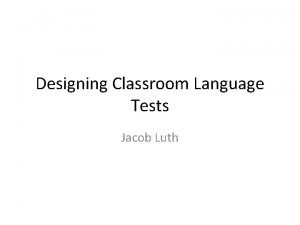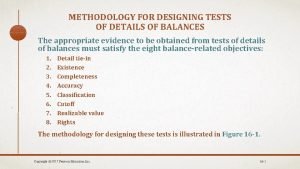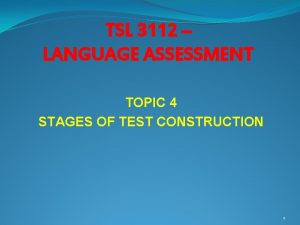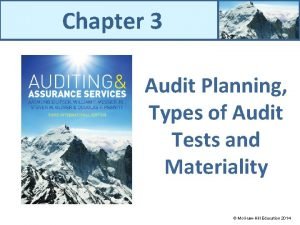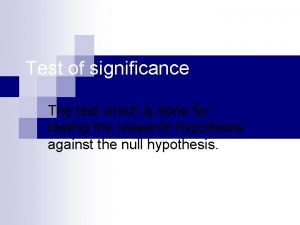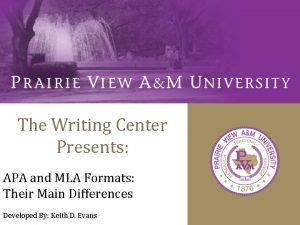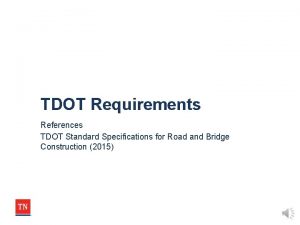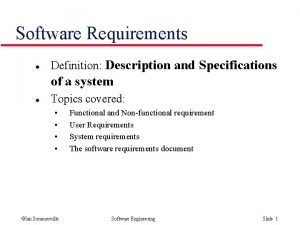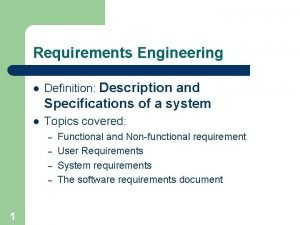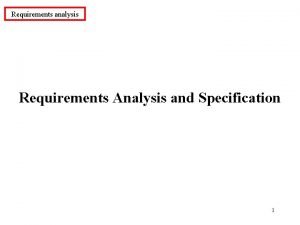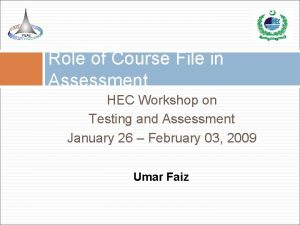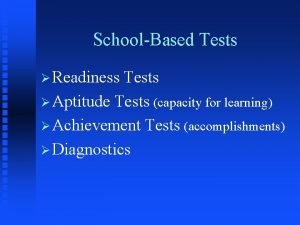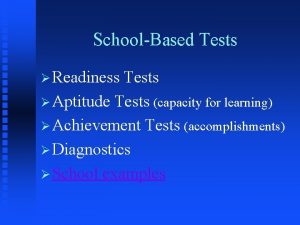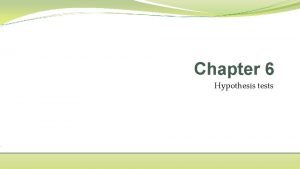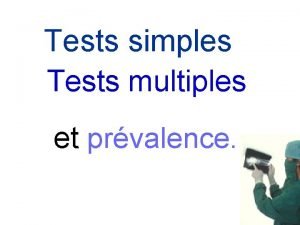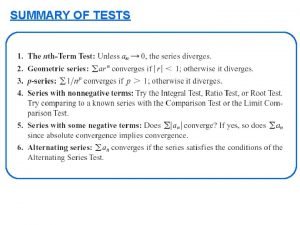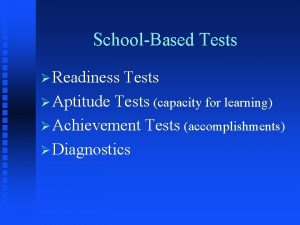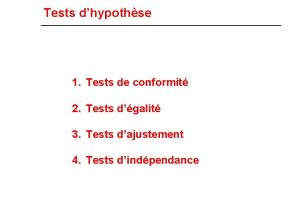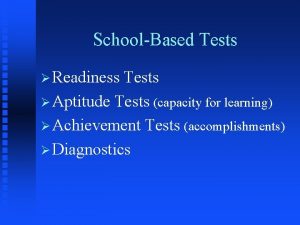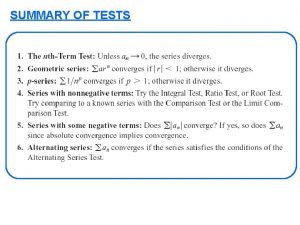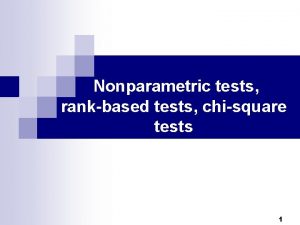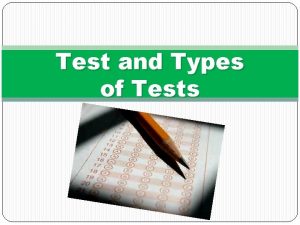Designing Classroom Tests Creating Test Specifications Test Types




















- Slides: 20

Designing Classroom Tests Creating Test Specifications

Test Types Language Aptitude Tests Language Proficiency Tests Placement Tests Diagnostic Tests Achievement Tests

Achievement Tests For our purposes, we will focus on achievement tests

First questions What are the purpose and the objectives of the course? What are the purpose and the objectives of the test? How will the test specifications reflect both the purpose and the objectives? How will the test tasks be selected and the separate items arranged? What kind of scoring, grading, and feedback is expected?

Test Specifications Determined by: Unit objectives l Relative importance of each objective l Classroom activities during the unit l What is practical (length of test, turnaround time) l Ways to increase formative washback l

Stating the testing ‘task’ What kind of test is it? What is the exact purpose, using Unit Objectives? What skills are to be tested? How detailed and how accurate must the results be? What are the stakes for the student? How important is backwash? What are any constraints (time, materials, etc. )?

Creating Clear Unit Objectives What should a student learn (or be able to do) at the end of the unit? These can be stated as: Performance goals l Organized by skill area These should be as stated as specifically as possible Example: l Communication Skills (speaking) Students will give opinions about an event in a social conversation.

Unit 1 – Intermediate 1 Duración 10 horas Vocabulario: Verbos en pasado y presente; Actividades cotidianas y recreativas; Días de la semana, meses del año y horas del día Gramática: Oraciones afirmativas y negativas, y preguntas con los auxiliares “Do”, “Did” y “Will”; Formular y contestar preguntas con “Wh” en pasado, presente y futuro Producción Oral: Dar y pedir información sobre actividades cotidianas; Obtener información detallada de un tema específico; Preguntas relacionadas con el tema de que se esté hablando Comprensión Auditiva: Identificar información especifica (scanning) para completar oraciones y preguntas Lectura: Obtener información especifica (scanning) sobre un itinerario Redacción: Generar 15 preguntas (brainstorm) para elaborar un cuestionario referente a una actividad cotidiana; Elegir 5 preguntas y revisarlas (proofreading) Pronunciación: Entonación de preguntas Autonomía: Compartir con los alumnos el análisis de autonomía y analizar los puntos con temas como: ¿Qué es aprender a aprender? , ¿Qué es autoaprendizaje? , etc.

Unit 1 – Intermediate 1 Duración 10 horas Vocabulario: Verbos en pasado y presente; Actividades cotidianas y recreativas; Días de la semana, meses del año y horas del día Gramática: Oraciones afirmativas y negativas, y preguntas con los auxiliares “Do”, “Did” y “Will”; Formular y contestar preguntas con “Wh” en pasado, presente y futuro Producción Oral: Dar y pedir información sobre actividades cotidianas; Obtener información detallada de un tema específico; Preguntas relacionadas con el tema de que se esté hablando Comprensión Auditiva: Identificar información especifica (scanning) para completar oraciones y preguntas Lectura: Obtener información especifica (scanning) sobre un itinerario Redacción: Generar 15 preguntas (brainstorm) para elaborar un cuestionario referente a una actividad cotidiana; Elegir 5 preguntas y revisarlas (proofreading) Pronunciación: Entonación de preguntas Autonomía: Compartir con los alumnos el análisis de autonomía y analizar los puntos con temas como: ¿Qué es aprender a aprender? , ¿Qué es autoaprendizaje? , etc.

Preparing Test Specifications Content Test structure Timing Medium Performance levels Scoring procedures (Hughes 2003, 59) For your program, are there any consistent test specs? (e. g. , Are all tests 45 minutes? Does each test include a speaking component? )

Writing Test Specs: Content The entire potential content of the test, with some used in different versions and sample tests The content should be described as fully as possible l For grammar: specific structures l For reading/listening: text lengths and difficulty Can you think of ways that content can be specified? l

Writing Test Specs: Structure/Timing How will the test be structured? l 3 sections, one reading, one listening, one writing How many items per section? How many passages The medium (paper, computer, phone) Timing for the test Techniques

Writing Test Specs: Measuring Performance & Scoring How will success be measured? For some sections, a percentage (80%) l Accuracy l Appropriateness l Range of specific language l Flexibility l Length of responses l How to score all this?

Writing Test Specifications Your task: In your group, write test specs for the objectives in the unit we looked at earlier. Try to include all the components discussed. Can you prioritize the objectives? Which of the objectives listed would you not put in the test? Why?

Creating the basic specs These specs help to l l l See the topics to cover Get a sense of elicitation/response formats Number of items Time necessary for each section Get a sense of what scoring/feedback will involve Are the most important objectives covered?

Elicitation Modes Oral l l l Word, pair of words Sentences Questions Directions Monologues Pre-recorded conversations ‘Live’ dialogue Written l l l l Word, set of words Sentences Questions Directions Paragraphs Essays or excerpts Short story or other longer passages

Response Modes Oral l l l l Repeating Reading aloud Answering yes/no Short response Describing Role play Monologues Interactive dialogue Written l l l Multiple choice Fill in the blank Spell a word Define a term (not complete sentences) Short answer essay

Creating the basic specs Speaking (__ minutes) l l Format: individual oral interview – 5 minutes Task: Teacher asks student questions, student responds appropriately Listening (__ minutes) l l Format: audiotape of 10 minimal pairs (jet/yet) Task: student marks correct word in multiple choice Reading (__ minutes) l l Format: 10 cloze items in a story Task: fill in the blanks Writing (__ minutes) l l Format: prompt for short essay: why I like… Task: write opinion paragraph

Creating the basic specs Speaking (__ minutes) l l Format: individual oral interview – 5 minutes Task: Teacher asks student questions, student responds appropriately Listening (__ minutes) l l Format: audiotape of 10 minimal pairs (jet/yet) Task: student marks correct word in multiple choice Reading (__ minutes) l l Format: 10 cloze items in a story Task: fill in the blanks Writing (__ minutes) l l Format: prompt for short essay: why I like… Task: write opinion paragraph

Next Step: Selecting items for a test When we have the test specs in place, with an idea of the techniques for each section, we need to write test items John Bunting (2004) presentation in the Course: Testing, Assessment and Teaching- A program for EFL Teachers at UABC. Facultad de Idiomas, UABC
 Classroom language test
Classroom language test Creating abn tests
Creating abn tests Ace different tests help iq still
Ace different tests help iq still Analytical procedures
Analytical procedures Positive classroom atmosphere
Positive classroom atmosphere Sourima mal
Sourima mal Drawing up test specifications
Drawing up test specifications Types of audit tests
Types of audit tests Test of significance
Test of significance Unit 10, unit 10 review tests, unit 10 general test
Unit 10, unit 10 review tests, unit 10 general test Mla format specifications
Mla format specifications Tdot standard specifications
Tdot standard specifications Apwa specifications
Apwa specifications High level requirements
High level requirements What is domain requirements
What is domain requirements Form-based specifications
Form-based specifications Application specifications
Application specifications Double seam inspection
Double seam inspection Table of specifications example
Table of specifications example Nao robot height
Nao robot height Boxn wagon dimensions
Boxn wagon dimensions
